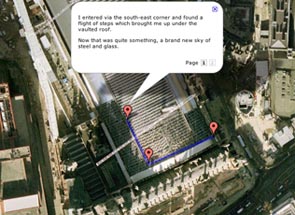Charles Cumming: The 21 Steps

"The 21 Steps" is a fast-paced, finely-tuned thriller that uses Google Maps to take the reader through the story's events. Written by British purveyor of spy thrillers, Charles Cumming, the story is told through Google's information bubbles with brief statements and images that take the reader from the streets of London to Edinburgh, Scotland with plenty of action and mini-cliffhangers along the way.
"The 21 Steps" is the first installment of the six-part "We Tell Stories" project by Penguin Books, which takes six contemporary writers and has them write a story based on a classic book. Cumming's classic was The 39 Steps by John Buchan. We spoke to Cumming about "The 21 Steps" and We Tell Stories.
How did you get involved with the We Tell Stories project?
I was approached by Penguin, who were keen to explore new ways of telling stories online, using a variety of different platforms. There are five stories on the site, all very different in style and content.
What made you decide on The 39 Steps and how did it influence your story?
The 39 Steps was also Penguin's idea. It's one of their most popular 'classic' titles and I think they were keen to introduce it, albeit indirectly, to a new audience. But it was also a very smart choice in terms of the Google Maps adventure. Buchan's tale is very light-hearted and pacy, full of cliffhangers, coincidences and contrived situations. That suited the style of "The 21 Steps" and gave me a template to work from.
Did you write the story independently of the map, or were they conceived together?
It was written very much in conjunction with the game designers, Six To Start. The process was collaborative from the word go. I would write a few short chapters and they would say: "Can you move the action outside?" or "Is it possible to build a visual clue into this section which will pay off later?" They also came up with the idea of having Rick run over the roof of Waverley Station because they knew that it would look good on the map. I've likened it to writing a screenplay, where producers and script editors and directors all have a say in the structure of a script. With novel writing you're more or less left to your own devices.
Did you find it limiting or freeing to write this way?
It was limiting only in the sense that I couldn't explore character in any great depth or get into the more psychological or emotional sides of the story. Plot was everything. Suspense was everything. It was all about pace and movement. But that in itself was quite exciting. Once I understood the parameters of what Penguin were trying to achieve, I had a lot of fun with it.
Are you considering any other similarly innovative storytelling techniques?
I'm still quite old-fashioned and believe in the beauty of the printed word, in the intimacy of a book. But I'm open to offers!
Read "The 21 Steps," along with the others, on the We Tell Stories page (click maps for further detail).












